Sustainable Management Plan for Early Childhood Education and Care
VerifiedAdded on 2023/04/21
|12
|2713
|128
AI Summary
This document discusses the importance of sustainability in early childhood education and care and provides a guide for implementing a sustainable management plan. It covers strategies for involving children and stakeholders, ideas for waste management and energy conservation, and considerations and challenges of adopting sustainable practices. The document also includes information on evaluating the outcomes of the plan.
Contribute Materials
Your contribution can guide someone’s learning journey. Share your
documents today.
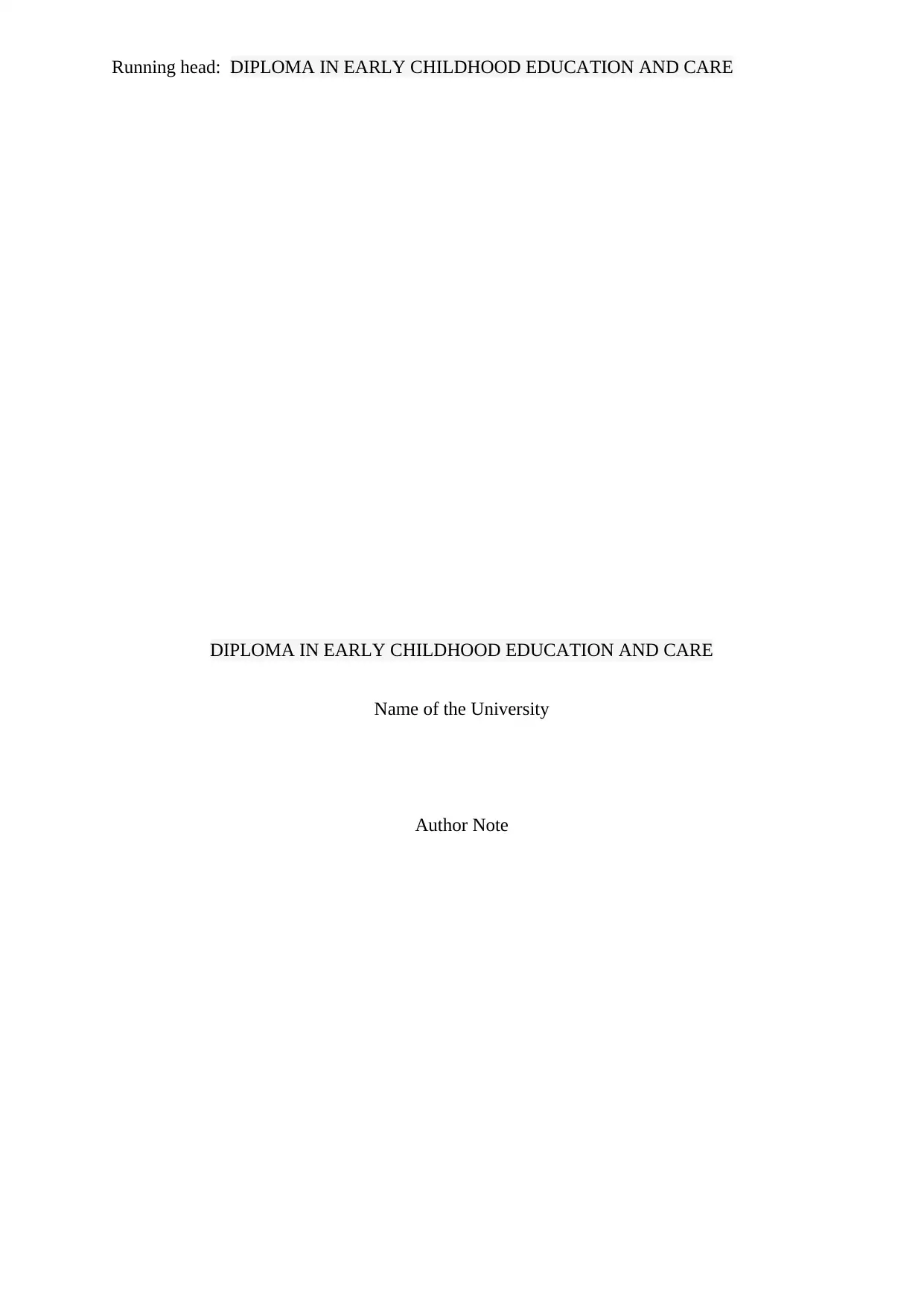
Running head: DIPLOMA IN EARLY CHILDHOOD EDUCATION AND CARE
DIPLOMA IN EARLY CHILDHOOD EDUCATION AND CARE
Name of the University
Author Note
DIPLOMA IN EARLY CHILDHOOD EDUCATION AND CARE
Name of the University
Author Note
Secure Best Marks with AI Grader
Need help grading? Try our AI Grader for instant feedback on your assignments.
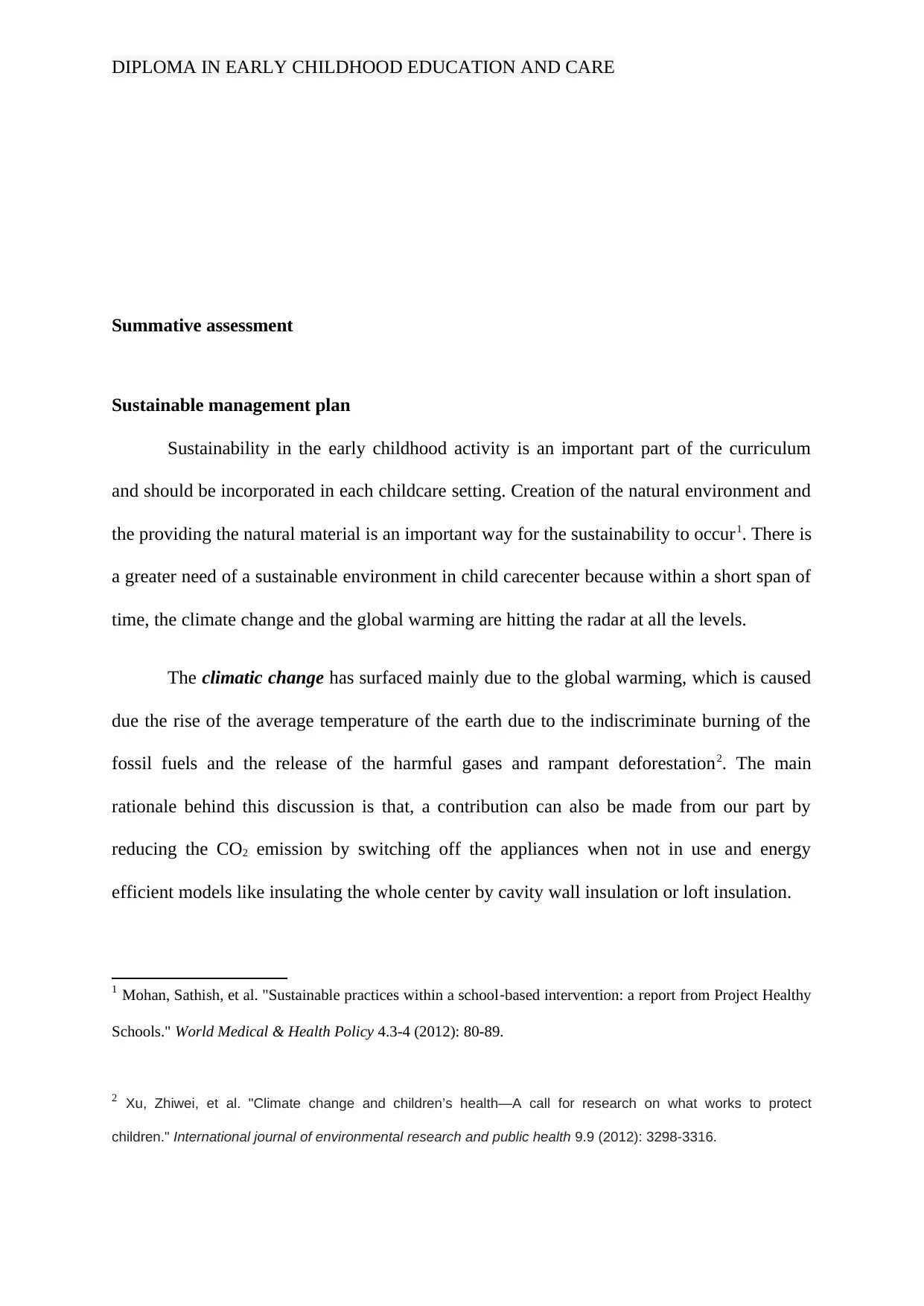
DIPLOMA IN EARLY CHILDHOOD EDUCATION AND CARE
Summative assessment
Sustainable management plan
Sustainability in the early childhood activity is an important part of the curriculum
and should be incorporated in each childcare setting. Creation of the natural environment and
the providing the natural material is an important way for the sustainability to occur1. There is
a greater need of a sustainable environment in child carecenter because within a short span of
time, the climate change and the global warming are hitting the radar at all the levels.
The climatic change has surfaced mainly due to the global warming, which is caused
due the rise of the average temperature of the earth due to the indiscriminate burning of the
fossil fuels and the release of the harmful gases and rampant deforestation2. The main
rationale behind this discussion is that, a contribution can also be made from our part by
reducing the CO2 emission by switching off the appliances when not in use and energy
efficient models like insulating the whole center by cavity wall insulation or loft insulation.
1 Mohan, Sathish, et al. "Sustainable practices within a school‐based intervention: a report from Project Healthy
Schools." World Medical & Health Policy 4.3-4 (2012): 80-89.
2 Xu, Zhiwei, et al. "Climate change and children’s health—A call for research on what works to protect
children." International journal of environmental research and public health 9.9 (2012): 3298-3316.
Summative assessment
Sustainable management plan
Sustainability in the early childhood activity is an important part of the curriculum
and should be incorporated in each childcare setting. Creation of the natural environment and
the providing the natural material is an important way for the sustainability to occur1. There is
a greater need of a sustainable environment in child carecenter because within a short span of
time, the climate change and the global warming are hitting the radar at all the levels.
The climatic change has surfaced mainly due to the global warming, which is caused
due the rise of the average temperature of the earth due to the indiscriminate burning of the
fossil fuels and the release of the harmful gases and rampant deforestation2. The main
rationale behind this discussion is that, a contribution can also be made from our part by
reducing the CO2 emission by switching off the appliances when not in use and energy
efficient models like insulating the whole center by cavity wall insulation or loft insulation.
1 Mohan, Sathish, et al. "Sustainable practices within a school‐based intervention: a report from Project Healthy
Schools." World Medical & Health Policy 4.3-4 (2012): 80-89.
2 Xu, Zhiwei, et al. "Climate change and children’s health—A call for research on what works to protect
children." International journal of environmental research and public health 9.9 (2012): 3298-3316.
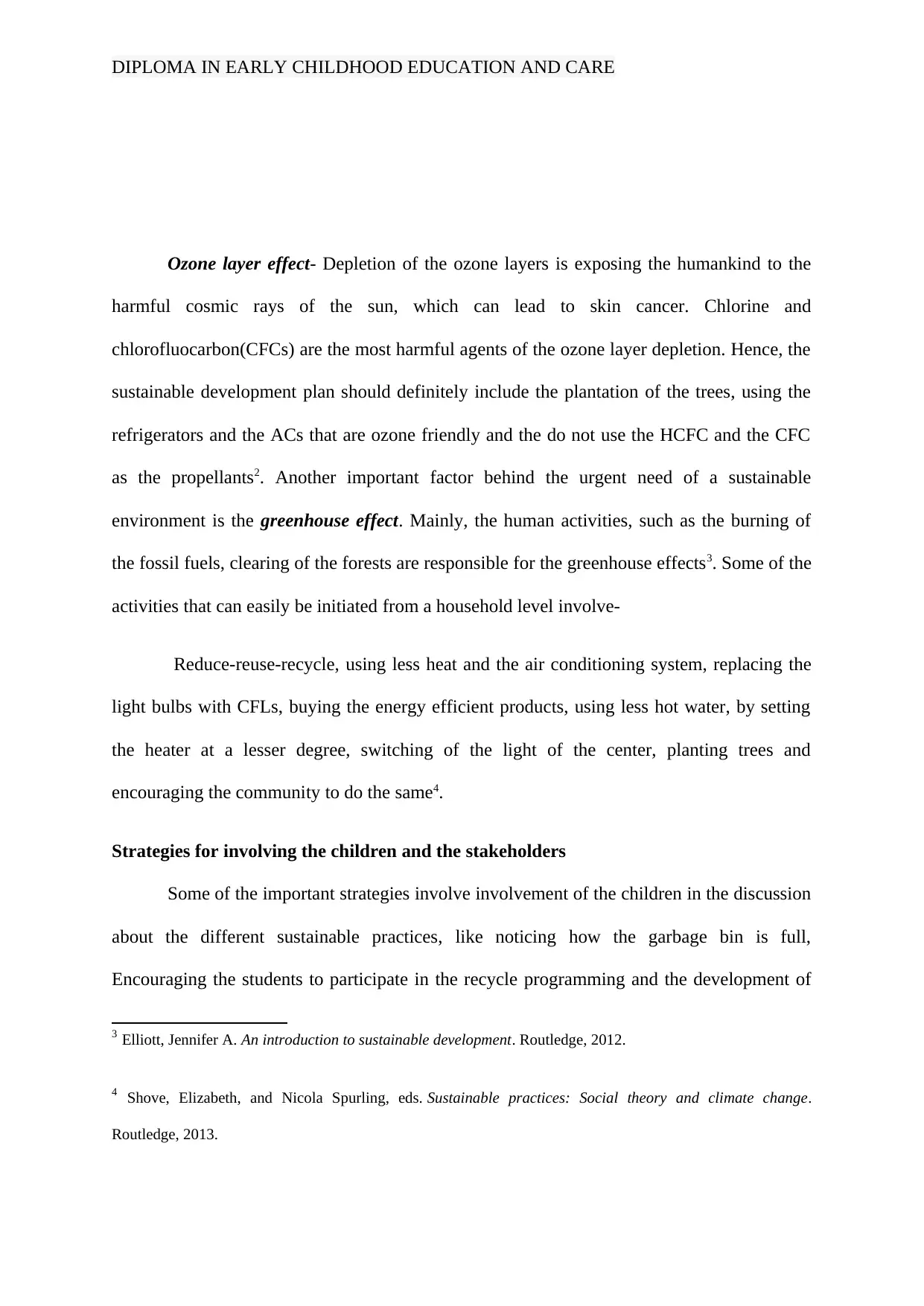
DIPLOMA IN EARLY CHILDHOOD EDUCATION AND CARE
Ozone layer effect- Depletion of the ozone layers is exposing the humankind to the
harmful cosmic rays of the sun, which can lead to skin cancer. Chlorine and
chlorofluocarbon(CFCs) are the most harmful agents of the ozone layer depletion. Hence, the
sustainable development plan should definitely include the plantation of the trees, using the
refrigerators and the ACs that are ozone friendly and the do not use the HCFC and the CFC
as the propellants2. Another important factor behind the urgent need of a sustainable
environment is the greenhouse effect. Mainly, the human activities, such as the burning of
the fossil fuels, clearing of the forests are responsible for the greenhouse effects3. Some of the
activities that can easily be initiated from a household level involve-
Reduce-reuse-recycle, using less heat and the air conditioning system, replacing the
light bulbs with CFLs, buying the energy efficient products, using less hot water, by setting
the heater at a lesser degree, switching of the light of the center, planting trees and
encouraging the community to do the same4.
Strategies for involving the children and the stakeholders
Some of the important strategies involve involvement of the children in the discussion
about the different sustainable practices, like noticing how the garbage bin is full,
Encouraging the students to participate in the recycle programming and the development of
3 Elliott, Jennifer A. An introduction to sustainable development. Routledge, 2012.
4 Shove, Elizabeth, and Nicola Spurling, eds. Sustainable practices: Social theory and climate change.
Routledge, 2013.
Ozone layer effect- Depletion of the ozone layers is exposing the humankind to the
harmful cosmic rays of the sun, which can lead to skin cancer. Chlorine and
chlorofluocarbon(CFCs) are the most harmful agents of the ozone layer depletion. Hence, the
sustainable development plan should definitely include the plantation of the trees, using the
refrigerators and the ACs that are ozone friendly and the do not use the HCFC and the CFC
as the propellants2. Another important factor behind the urgent need of a sustainable
environment is the greenhouse effect. Mainly, the human activities, such as the burning of
the fossil fuels, clearing of the forests are responsible for the greenhouse effects3. Some of the
activities that can easily be initiated from a household level involve-
Reduce-reuse-recycle, using less heat and the air conditioning system, replacing the
light bulbs with CFLs, buying the energy efficient products, using less hot water, by setting
the heater at a lesser degree, switching of the light of the center, planting trees and
encouraging the community to do the same4.
Strategies for involving the children and the stakeholders
Some of the important strategies involve involvement of the children in the discussion
about the different sustainable practices, like noticing how the garbage bin is full,
Encouraging the students to participate in the recycle programming and the development of
3 Elliott, Jennifer A. An introduction to sustainable development. Routledge, 2012.
4 Shove, Elizabeth, and Nicola Spurling, eds. Sustainable practices: Social theory and climate change.
Routledge, 2013.
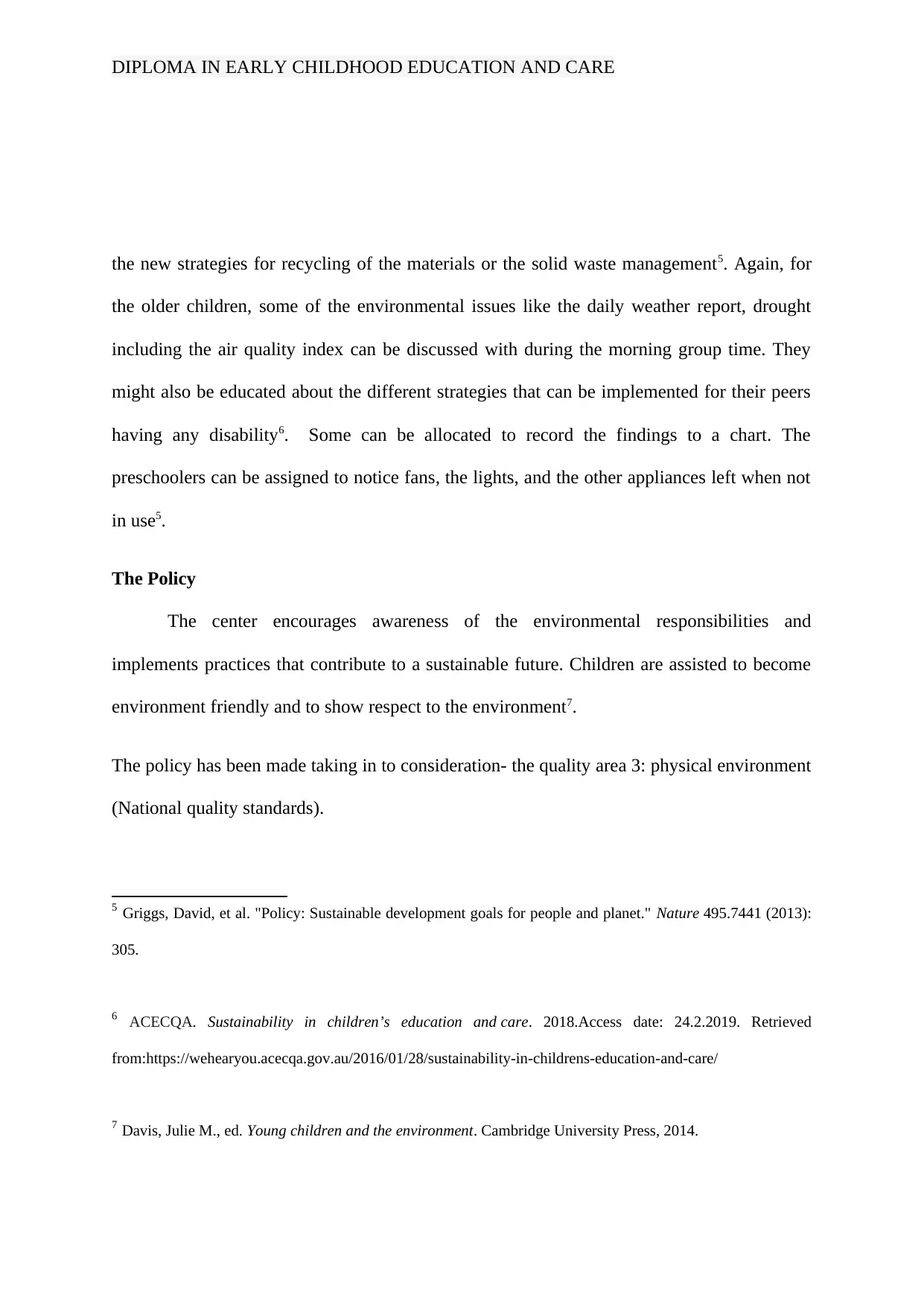
DIPLOMA IN EARLY CHILDHOOD EDUCATION AND CARE
the new strategies for recycling of the materials or the solid waste management5. Again, for
the older children, some of the environmental issues like the daily weather report, drought
including the air quality index can be discussed with during the morning group time. They
might also be educated about the different strategies that can be implemented for their peers
having any disability6. Some can be allocated to record the findings to a chart. The
preschoolers can be assigned to notice fans, the lights, and the other appliances left when not
in use5.
The Policy
The center encourages awareness of the environmental responsibilities and
implements practices that contribute to a sustainable future. Children are assisted to become
environment friendly and to show respect to the environment7.
The policy has been made taking in to consideration- the quality area 3: physical environment
(National quality standards).
5 Griggs, David, et al. "Policy: Sustainable development goals for people and planet." Nature 495.7441 (2013):
305.
6 ACECQA. Sustainability in children’s education and care. 2018.Access date: 24.2.2019. Retrieved
from:https://wehearyou.acecqa.gov.au/2016/01/28/sustainability-in-childrens-education-and-care/
7 Davis, Julie M., ed. Young children and the environment. Cambridge University Press, 2014.
the new strategies for recycling of the materials or the solid waste management5. Again, for
the older children, some of the environmental issues like the daily weather report, drought
including the air quality index can be discussed with during the morning group time. They
might also be educated about the different strategies that can be implemented for their peers
having any disability6. Some can be allocated to record the findings to a chart. The
preschoolers can be assigned to notice fans, the lights, and the other appliances left when not
in use5.
The Policy
The center encourages awareness of the environmental responsibilities and
implements practices that contribute to a sustainable future. Children are assisted to become
environment friendly and to show respect to the environment7.
The policy has been made taking in to consideration- the quality area 3: physical environment
(National quality standards).
5 Griggs, David, et al. "Policy: Sustainable development goals for people and planet." Nature 495.7441 (2013):
305.
6 ACECQA. Sustainability in children’s education and care. 2018.Access date: 24.2.2019. Retrieved
from:https://wehearyou.acecqa.gov.au/2016/01/28/sustainability-in-childrens-education-and-care/
7 Davis, Julie M., ed. Young children and the environment. Cambridge University Press, 2014.
Secure Best Marks with AI Grader
Need help grading? Try our AI Grader for instant feedback on your assignments.
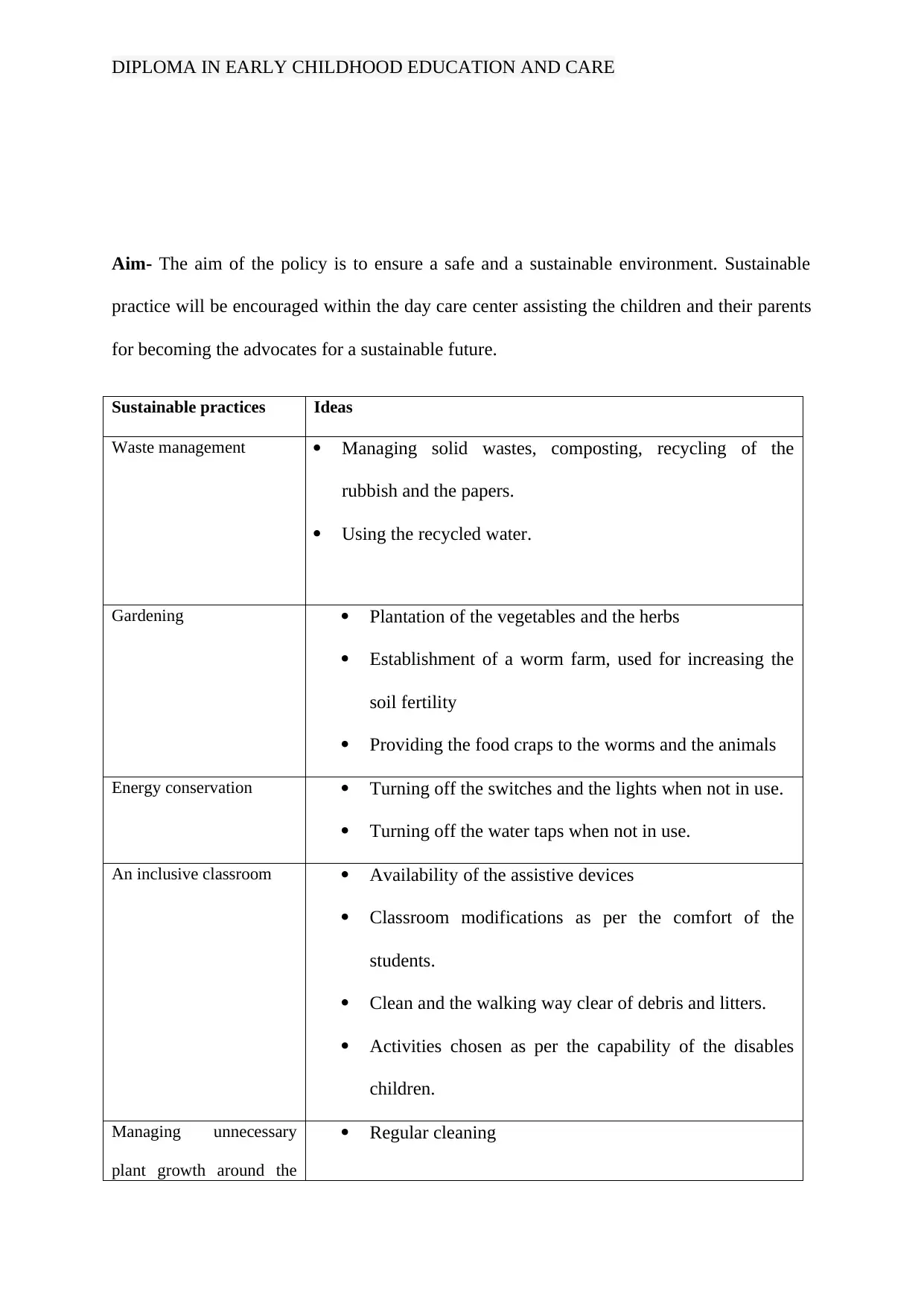
DIPLOMA IN EARLY CHILDHOOD EDUCATION AND CARE
Aim- The aim of the policy is to ensure a safe and a sustainable environment. Sustainable
practice will be encouraged within the day care center assisting the children and their parents
for becoming the advocates for a sustainable future.
Sustainable practices Ideas
Waste management Managing solid wastes, composting, recycling of the
rubbish and the papers.
Using the recycled water.
Gardening Plantation of the vegetables and the herbs
Establishment of a worm farm, used for increasing the
soil fertility
Providing the food craps to the worms and the animals
Energy conservation Turning off the switches and the lights when not in use.
Turning off the water taps when not in use.
An inclusive classroom Availability of the assistive devices
Classroom modifications as per the comfort of the
students.
Clean and the walking way clear of debris and litters.
Activities chosen as per the capability of the disables
children.
Managing unnecessary
plant growth around the
Regular cleaning
Aim- The aim of the policy is to ensure a safe and a sustainable environment. Sustainable
practice will be encouraged within the day care center assisting the children and their parents
for becoming the advocates for a sustainable future.
Sustainable practices Ideas
Waste management Managing solid wastes, composting, recycling of the
rubbish and the papers.
Using the recycled water.
Gardening Plantation of the vegetables and the herbs
Establishment of a worm farm, used for increasing the
soil fertility
Providing the food craps to the worms and the animals
Energy conservation Turning off the switches and the lights when not in use.
Turning off the water taps when not in use.
An inclusive classroom Availability of the assistive devices
Classroom modifications as per the comfort of the
students.
Clean and the walking way clear of debris and litters.
Activities chosen as per the capability of the disables
children.
Managing unnecessary
plant growth around the
Regular cleaning
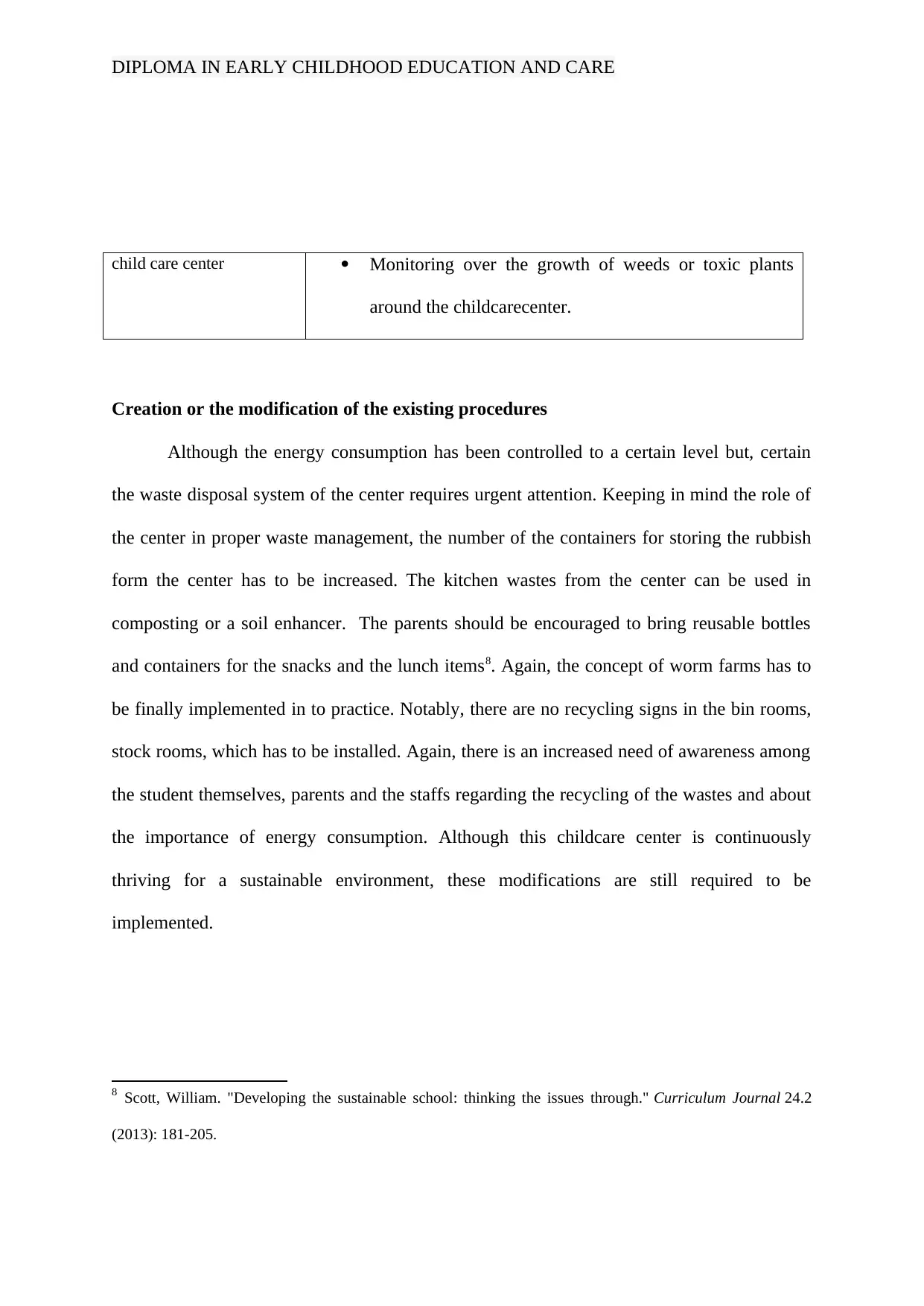
DIPLOMA IN EARLY CHILDHOOD EDUCATION AND CARE
child care center Monitoring over the growth of weeds or toxic plants
around the childcarecenter.
Creation or the modification of the existing procedures
Although the energy consumption has been controlled to a certain level but, certain
the waste disposal system of the center requires urgent attention. Keeping in mind the role of
the center in proper waste management, the number of the containers for storing the rubbish
form the center has to be increased. The kitchen wastes from the center can be used in
composting or a soil enhancer. The parents should be encouraged to bring reusable bottles
and containers for the snacks and the lunch items8. Again, the concept of worm farms has to
be finally implemented in to practice. Notably, there are no recycling signs in the bin rooms,
stock rooms, which has to be installed. Again, there is an increased need of awareness among
the student themselves, parents and the staffs regarding the recycling of the wastes and about
the importance of energy consumption. Although this childcare center is continuously
thriving for a sustainable environment, these modifications are still required to be
implemented.
8 Scott, William. "Developing the sustainable school: thinking the issues through." Curriculum Journal 24.2
(2013): 181-205.
child care center Monitoring over the growth of weeds or toxic plants
around the childcarecenter.
Creation or the modification of the existing procedures
Although the energy consumption has been controlled to a certain level but, certain
the waste disposal system of the center requires urgent attention. Keeping in mind the role of
the center in proper waste management, the number of the containers for storing the rubbish
form the center has to be increased. The kitchen wastes from the center can be used in
composting or a soil enhancer. The parents should be encouraged to bring reusable bottles
and containers for the snacks and the lunch items8. Again, the concept of worm farms has to
be finally implemented in to practice. Notably, there are no recycling signs in the bin rooms,
stock rooms, which has to be installed. Again, there is an increased need of awareness among
the student themselves, parents and the staffs regarding the recycling of the wastes and about
the importance of energy consumption. Although this childcare center is continuously
thriving for a sustainable environment, these modifications are still required to be
implemented.
8 Scott, William. "Developing the sustainable school: thinking the issues through." Curriculum Journal 24.2
(2013): 181-205.
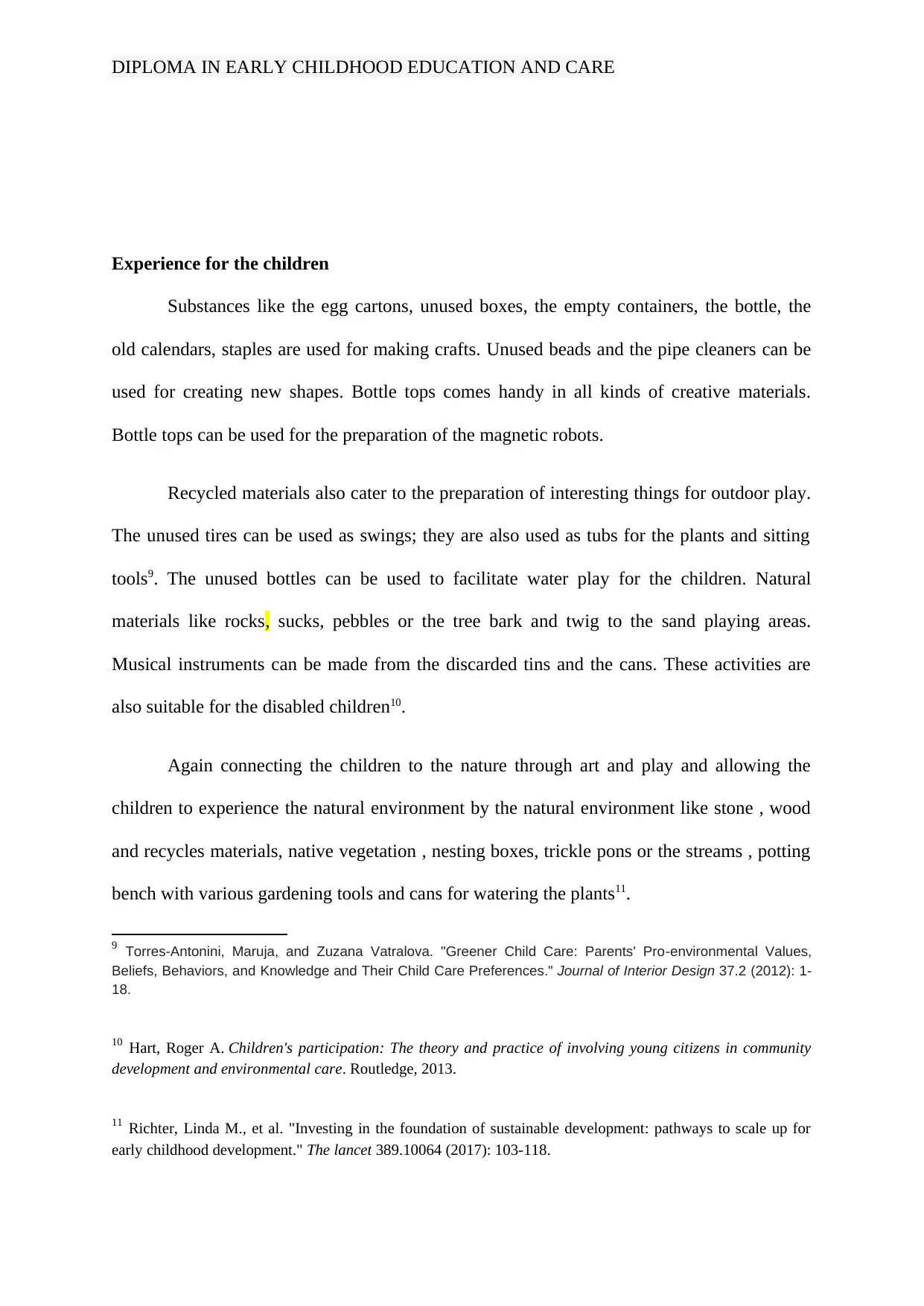
DIPLOMA IN EARLY CHILDHOOD EDUCATION AND CARE
Experience for the children
Substances like the egg cartons, unused boxes, the empty containers, the bottle, the
old calendars, staples are used for making crafts. Unused beads and the pipe cleaners can be
used for creating new shapes. Bottle tops comes handy in all kinds of creative materials.
Bottle tops can be used for the preparation of the magnetic robots.
Recycled materials also cater to the preparation of interesting things for outdoor play.
The unused tires can be used as swings; they are also used as tubs for the plants and sitting
tools9. The unused bottles can be used to facilitate water play for the children. Natural
materials like rocks, sucks, pebbles or the tree bark and twig to the sand playing areas.
Musical instruments can be made from the discarded tins and the cans. These activities are
also suitable for the disabled children10.
Again connecting the children to the nature through art and play and allowing the
children to experience the natural environment by the natural environment like stone , wood
and recycles materials, native vegetation , nesting boxes, trickle pons or the streams , potting
bench with various gardening tools and cans for watering the plants11.
9 Torres‐Antonini, Maruja, and Zuzana Vatralova. "Greener Child Care: Parents' Pro‐environmental Values,
Beliefs, Behaviors, and Knowledge and Their Child Care Preferences." Journal of Interior Design 37.2 (2012): 1-
18.
10 Hart, Roger A. Children's participation: The theory and practice of involving young citizens in community
development and environmental care. Routledge, 2013.
11 Richter, Linda M., et al. "Investing in the foundation of sustainable development: pathways to scale up for
early childhood development." The lancet 389.10064 (2017): 103-118.
Experience for the children
Substances like the egg cartons, unused boxes, the empty containers, the bottle, the
old calendars, staples are used for making crafts. Unused beads and the pipe cleaners can be
used for creating new shapes. Bottle tops comes handy in all kinds of creative materials.
Bottle tops can be used for the preparation of the magnetic robots.
Recycled materials also cater to the preparation of interesting things for outdoor play.
The unused tires can be used as swings; they are also used as tubs for the plants and sitting
tools9. The unused bottles can be used to facilitate water play for the children. Natural
materials like rocks, sucks, pebbles or the tree bark and twig to the sand playing areas.
Musical instruments can be made from the discarded tins and the cans. These activities are
also suitable for the disabled children10.
Again connecting the children to the nature through art and play and allowing the
children to experience the natural environment by the natural environment like stone , wood
and recycles materials, native vegetation , nesting boxes, trickle pons or the streams , potting
bench with various gardening tools and cans for watering the plants11.
9 Torres‐Antonini, Maruja, and Zuzana Vatralova. "Greener Child Care: Parents' Pro‐environmental Values,
Beliefs, Behaviors, and Knowledge and Their Child Care Preferences." Journal of Interior Design 37.2 (2012): 1-
18.
10 Hart, Roger A. Children's participation: The theory and practice of involving young citizens in community
development and environmental care. Routledge, 2013.
11 Richter, Linda M., et al. "Investing in the foundation of sustainable development: pathways to scale up for
early childhood development." The lancet 389.10064 (2017): 103-118.
Paraphrase This Document
Need a fresh take? Get an instant paraphrase of this document with our AI Paraphraser
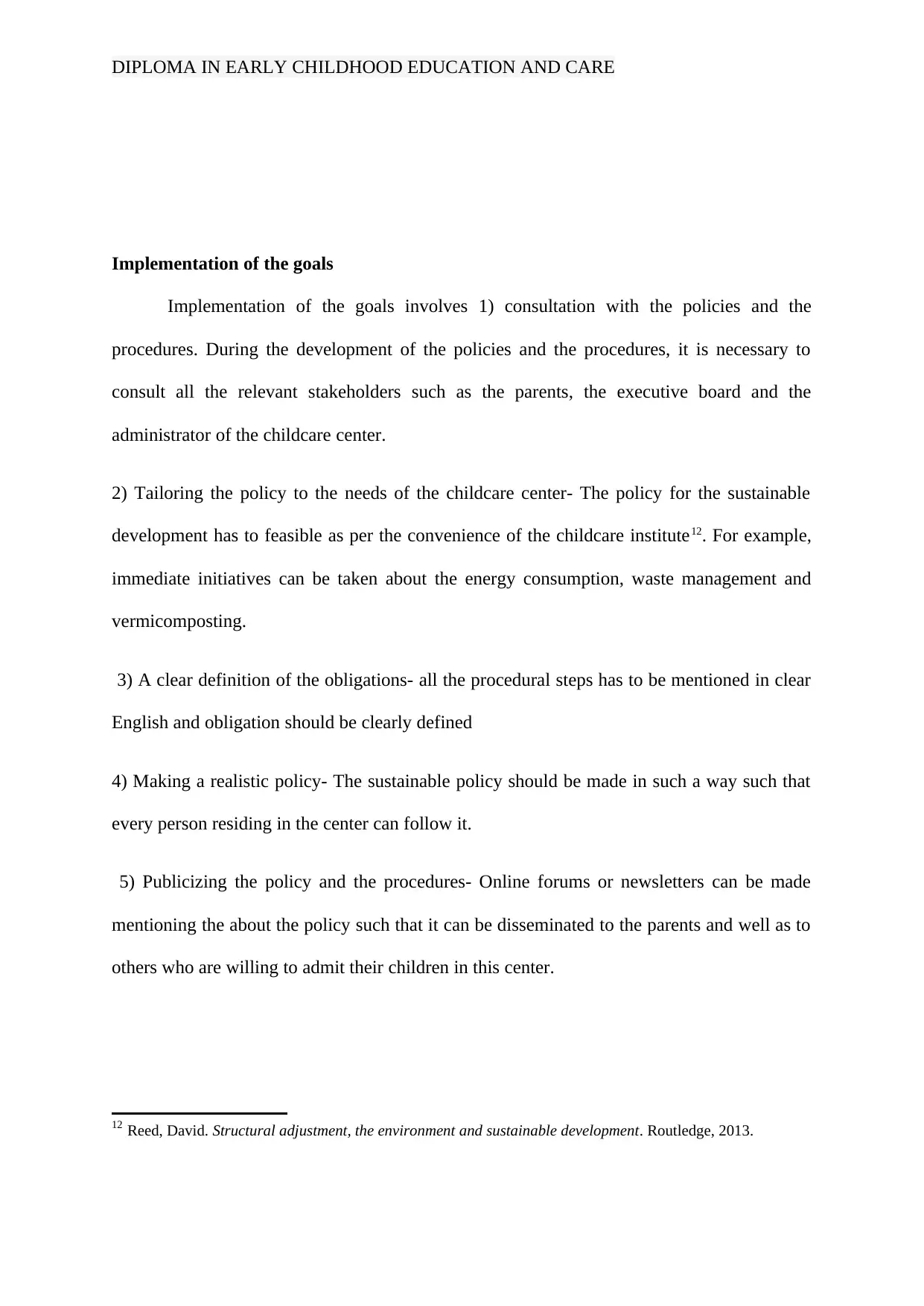
DIPLOMA IN EARLY CHILDHOOD EDUCATION AND CARE
Implementation of the goals
Implementation of the goals involves 1) consultation with the policies and the
procedures. During the development of the policies and the procedures, it is necessary to
consult all the relevant stakeholders such as the parents, the executive board and the
administrator of the childcare center.
2) Tailoring the policy to the needs of the childcare center- The policy for the sustainable
development has to feasible as per the convenience of the childcare institute12. For example,
immediate initiatives can be taken about the energy consumption, waste management and
vermicomposting.
3) A clear definition of the obligations- all the procedural steps has to be mentioned in clear
English and obligation should be clearly defined
4) Making a realistic policy- The sustainable policy should be made in such a way such that
every person residing in the center can follow it.
5) Publicizing the policy and the procedures- Online forums or newsletters can be made
mentioning the about the policy such that it can be disseminated to the parents and well as to
others who are willing to admit their children in this center.
12 Reed, David. Structural adjustment, the environment and sustainable development. Routledge, 2013.
Implementation of the goals
Implementation of the goals involves 1) consultation with the policies and the
procedures. During the development of the policies and the procedures, it is necessary to
consult all the relevant stakeholders such as the parents, the executive board and the
administrator of the childcare center.
2) Tailoring the policy to the needs of the childcare center- The policy for the sustainable
development has to feasible as per the convenience of the childcare institute12. For example,
immediate initiatives can be taken about the energy consumption, waste management and
vermicomposting.
3) A clear definition of the obligations- all the procedural steps has to be mentioned in clear
English and obligation should be clearly defined
4) Making a realistic policy- The sustainable policy should be made in such a way such that
every person residing in the center can follow it.
5) Publicizing the policy and the procedures- Online forums or newsletters can be made
mentioning the about the policy such that it can be disseminated to the parents and well as to
others who are willing to admit their children in this center.
12 Reed, David. Structural adjustment, the environment and sustainable development. Routledge, 2013.
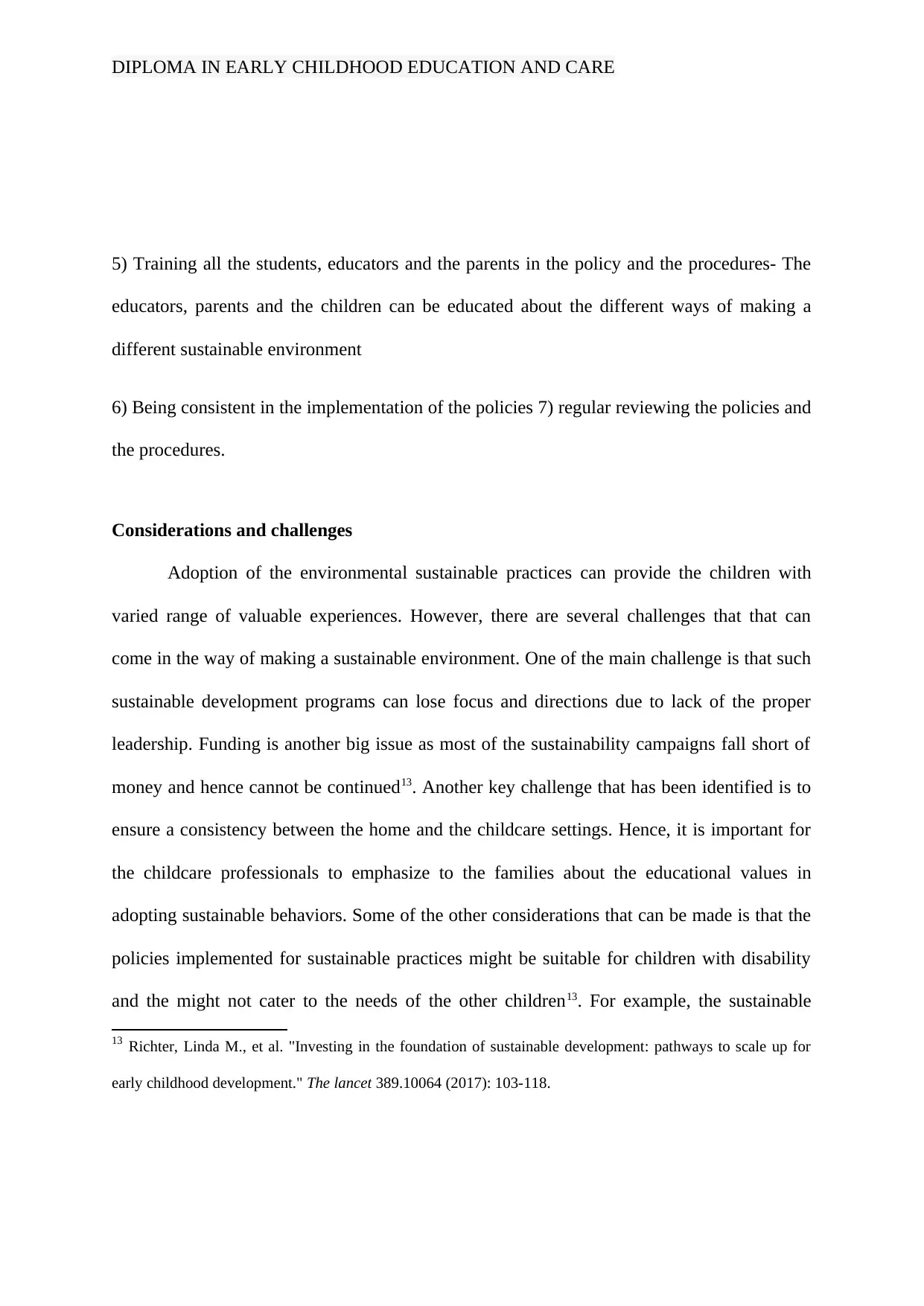
DIPLOMA IN EARLY CHILDHOOD EDUCATION AND CARE
5) Training all the students, educators and the parents in the policy and the procedures- The
educators, parents and the children can be educated about the different ways of making a
different sustainable environment
6) Being consistent in the implementation of the policies 7) regular reviewing the policies and
the procedures.
Considerations and challenges
Adoption of the environmental sustainable practices can provide the children with
varied range of valuable experiences. However, there are several challenges that that can
come in the way of making a sustainable environment. One of the main challenge is that such
sustainable development programs can lose focus and directions due to lack of the proper
leadership. Funding is another big issue as most of the sustainability campaigns fall short of
money and hence cannot be continued13. Another key challenge that has been identified is to
ensure a consistency between the home and the childcare settings. Hence, it is important for
the childcare professionals to emphasize to the families about the educational values in
adopting sustainable behaviors. Some of the other considerations that can be made is that the
policies implemented for sustainable practices might be suitable for children with disability
and the might not cater to the needs of the other children13. For example, the sustainable
13 Richter, Linda M., et al. "Investing in the foundation of sustainable development: pathways to scale up for
early childhood development." The lancet 389.10064 (2017): 103-118.
5) Training all the students, educators and the parents in the policy and the procedures- The
educators, parents and the children can be educated about the different ways of making a
different sustainable environment
6) Being consistent in the implementation of the policies 7) regular reviewing the policies and
the procedures.
Considerations and challenges
Adoption of the environmental sustainable practices can provide the children with
varied range of valuable experiences. However, there are several challenges that that can
come in the way of making a sustainable environment. One of the main challenge is that such
sustainable development programs can lose focus and directions due to lack of the proper
leadership. Funding is another big issue as most of the sustainability campaigns fall short of
money and hence cannot be continued13. Another key challenge that has been identified is to
ensure a consistency between the home and the childcare settings. Hence, it is important for
the childcare professionals to emphasize to the families about the educational values in
adopting sustainable behaviors. Some of the other considerations that can be made is that the
policies implemented for sustainable practices might be suitable for children with disability
and the might not cater to the needs of the other children13. For example, the sustainable
13 Richter, Linda M., et al. "Investing in the foundation of sustainable development: pathways to scale up for
early childhood development." The lancet 389.10064 (2017): 103-118.
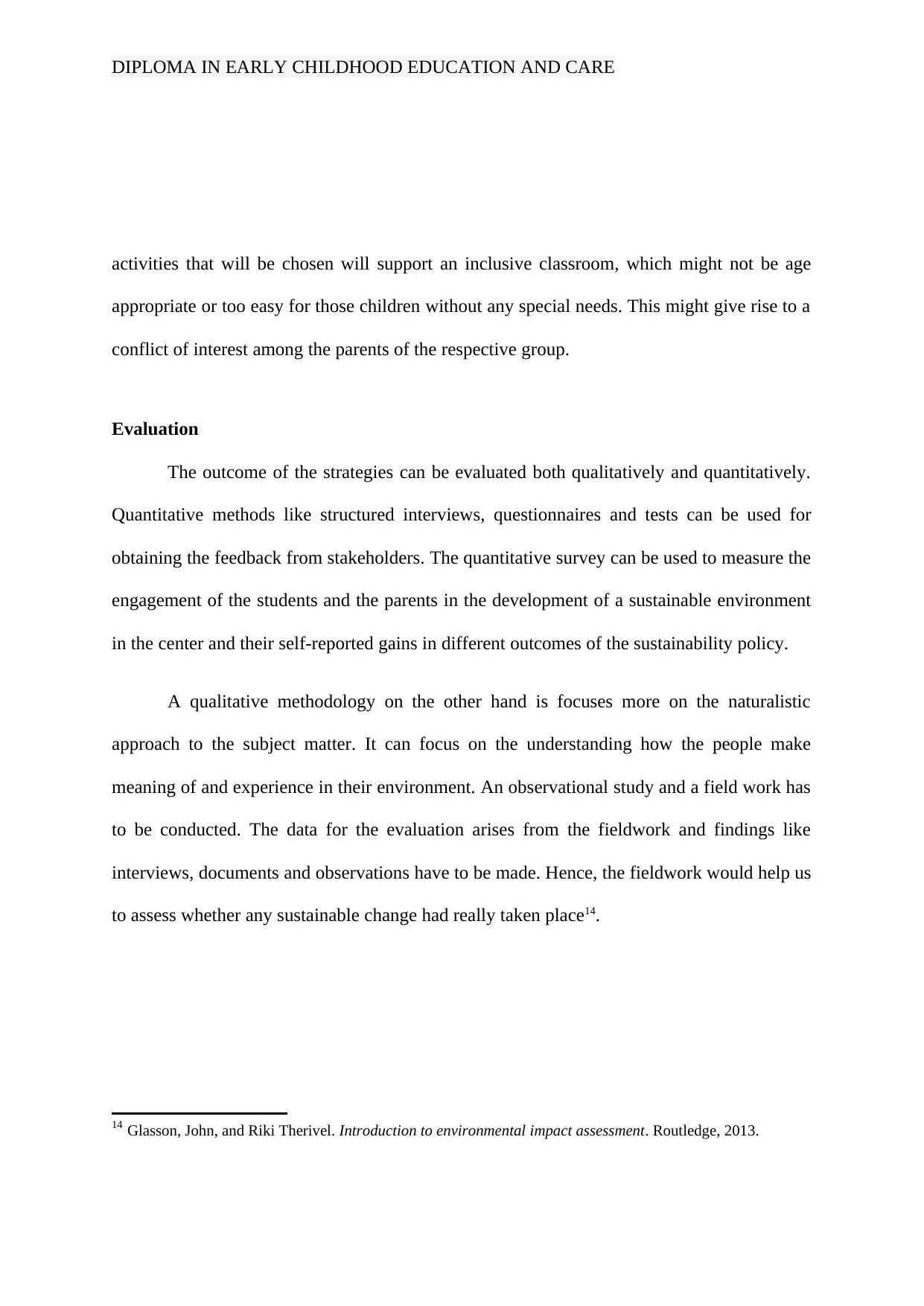
DIPLOMA IN EARLY CHILDHOOD EDUCATION AND CARE
activities that will be chosen will support an inclusive classroom, which might not be age
appropriate or too easy for those children without any special needs. This might give rise to a
conflict of interest among the parents of the respective group.
Evaluation
The outcome of the strategies can be evaluated both qualitatively and quantitatively.
Quantitative methods like structured interviews, questionnaires and tests can be used for
obtaining the feedback from stakeholders. The quantitative survey can be used to measure the
engagement of the students and the parents in the development of a sustainable environment
in the center and their self-reported gains in different outcomes of the sustainability policy.
A qualitative methodology on the other hand is focuses more on the naturalistic
approach to the subject matter. It can focus on the understanding how the people make
meaning of and experience in their environment. An observational study and a field work has
to be conducted. The data for the evaluation arises from the fieldwork and findings like
interviews, documents and observations have to be made. Hence, the fieldwork would help us
to assess whether any sustainable change had really taken place14.
14 Glasson, John, and Riki Therivel. Introduction to environmental impact assessment. Routledge, 2013.
activities that will be chosen will support an inclusive classroom, which might not be age
appropriate or too easy for those children without any special needs. This might give rise to a
conflict of interest among the parents of the respective group.
Evaluation
The outcome of the strategies can be evaluated both qualitatively and quantitatively.
Quantitative methods like structured interviews, questionnaires and tests can be used for
obtaining the feedback from stakeholders. The quantitative survey can be used to measure the
engagement of the students and the parents in the development of a sustainable environment
in the center and their self-reported gains in different outcomes of the sustainability policy.
A qualitative methodology on the other hand is focuses more on the naturalistic
approach to the subject matter. It can focus on the understanding how the people make
meaning of and experience in their environment. An observational study and a field work has
to be conducted. The data for the evaluation arises from the fieldwork and findings like
interviews, documents and observations have to be made. Hence, the fieldwork would help us
to assess whether any sustainable change had really taken place14.
14 Glasson, John, and Riki Therivel. Introduction to environmental impact assessment. Routledge, 2013.
Secure Best Marks with AI Grader
Need help grading? Try our AI Grader for instant feedback on your assignments.
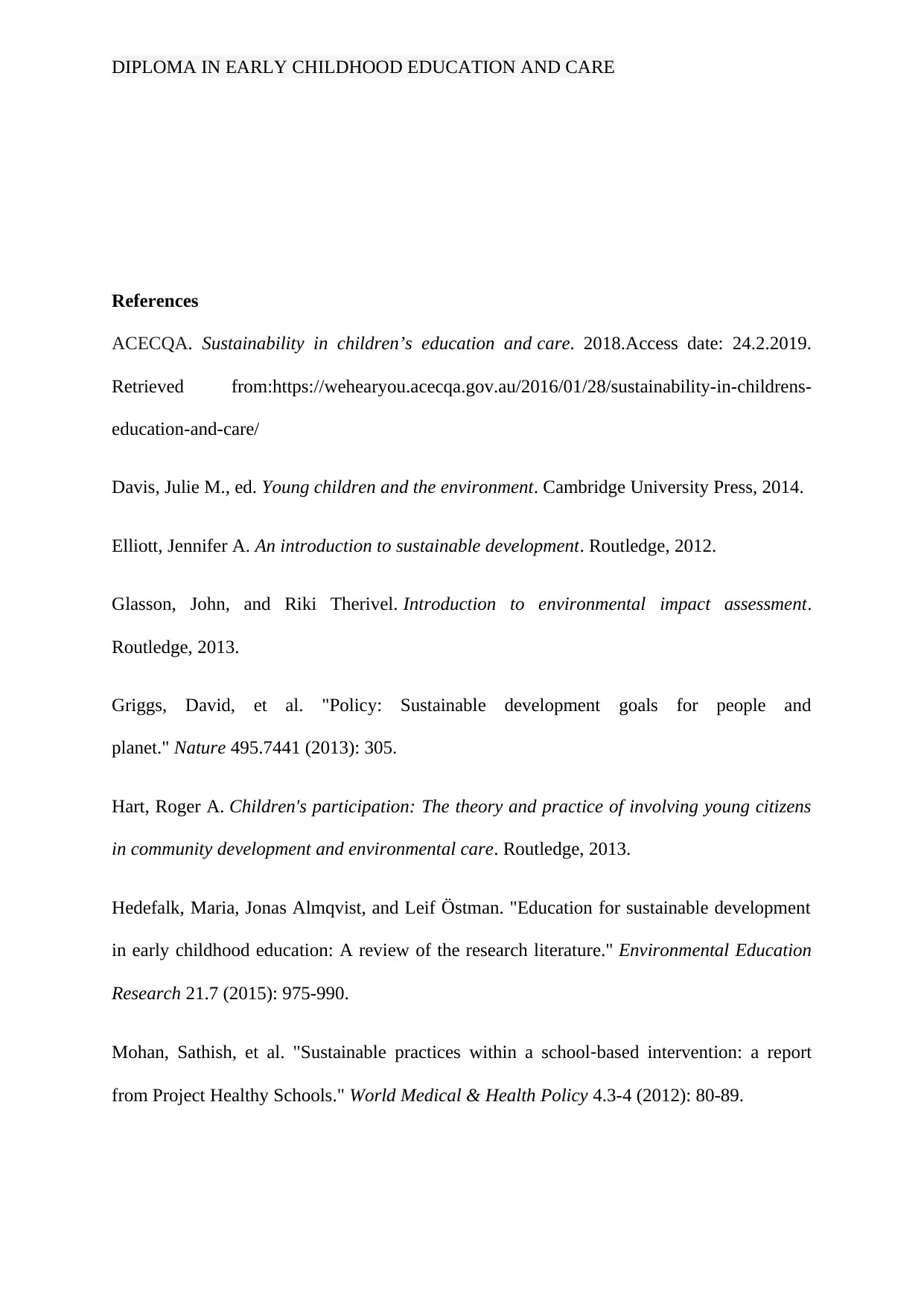
DIPLOMA IN EARLY CHILDHOOD EDUCATION AND CARE
References
ACECQA. Sustainability in children’s education and care. 2018.Access date: 24.2.2019.
Retrieved from:https://wehearyou.acecqa.gov.au/2016/01/28/sustainability-in-childrens-
education-and-care/
Davis, Julie M., ed. Young children and the environment. Cambridge University Press, 2014.
Elliott, Jennifer A. An introduction to sustainable development. Routledge, 2012.
Glasson, John, and Riki Therivel. Introduction to environmental impact assessment.
Routledge, 2013.
Griggs, David, et al. "Policy: Sustainable development goals for people and
planet." Nature 495.7441 (2013): 305.
Hart, Roger A. Children's participation: The theory and practice of involving young citizens
in community development and environmental care. Routledge, 2013.
Hedefalk, Maria, Jonas Almqvist, and Leif Östman. "Education for sustainable development
in early childhood education: A review of the research literature." Environmental Education
Research 21.7 (2015): 975-990.
Mohan, Sathish, et al. "Sustainable practices within a school‐based intervention: a report
from Project Healthy Schools." World Medical & Health Policy 4.3-4 (2012): 80-89.
References
ACECQA. Sustainability in children’s education and care. 2018.Access date: 24.2.2019.
Retrieved from:https://wehearyou.acecqa.gov.au/2016/01/28/sustainability-in-childrens-
education-and-care/
Davis, Julie M., ed. Young children and the environment. Cambridge University Press, 2014.
Elliott, Jennifer A. An introduction to sustainable development. Routledge, 2012.
Glasson, John, and Riki Therivel. Introduction to environmental impact assessment.
Routledge, 2013.
Griggs, David, et al. "Policy: Sustainable development goals for people and
planet." Nature 495.7441 (2013): 305.
Hart, Roger A. Children's participation: The theory and practice of involving young citizens
in community development and environmental care. Routledge, 2013.
Hedefalk, Maria, Jonas Almqvist, and Leif Östman. "Education for sustainable development
in early childhood education: A review of the research literature." Environmental Education
Research 21.7 (2015): 975-990.
Mohan, Sathish, et al. "Sustainable practices within a school‐based intervention: a report
from Project Healthy Schools." World Medical & Health Policy 4.3-4 (2012): 80-89.
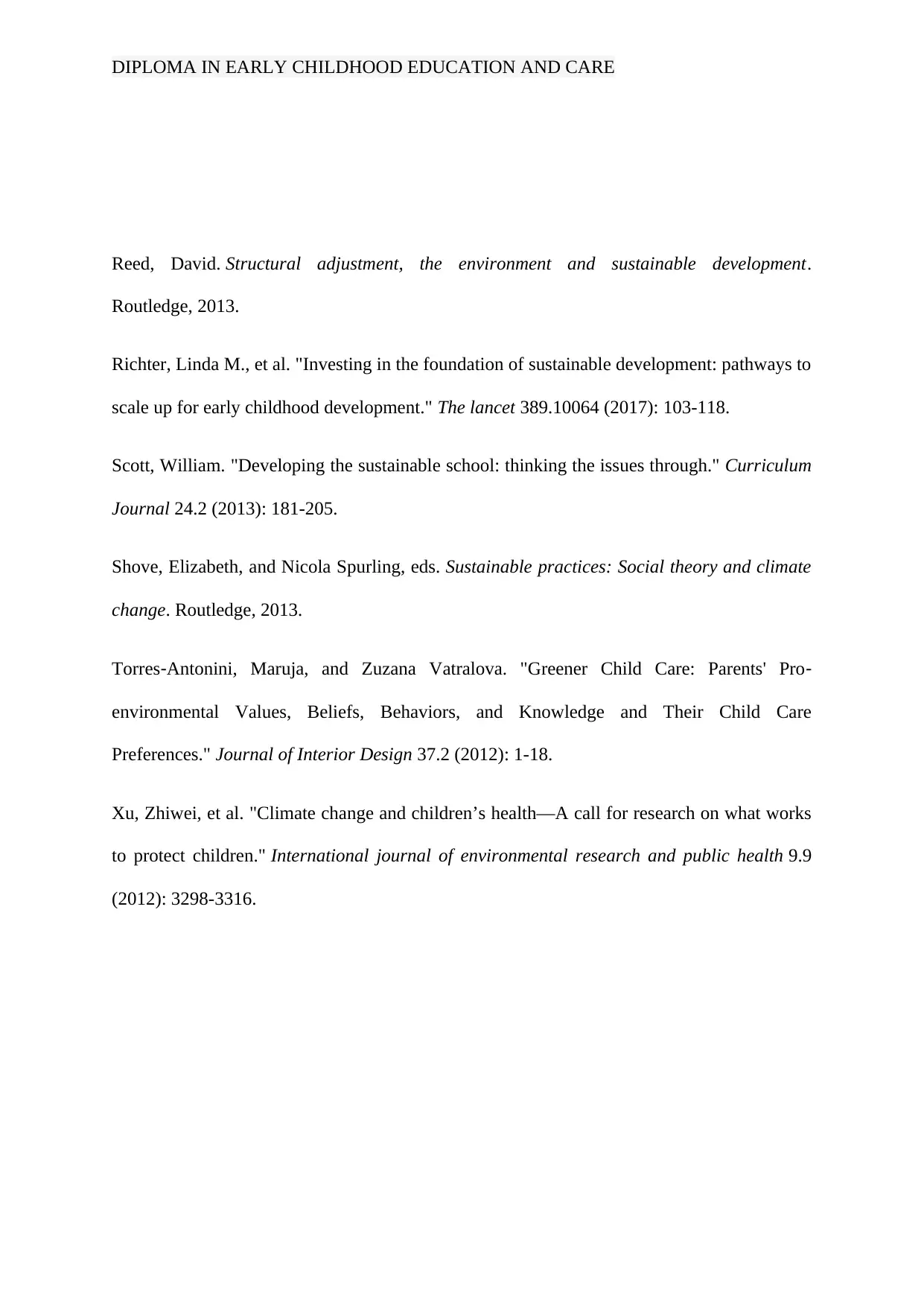
DIPLOMA IN EARLY CHILDHOOD EDUCATION AND CARE
Reed, David. Structural adjustment, the environment and sustainable development.
Routledge, 2013.
Richter, Linda M., et al. "Investing in the foundation of sustainable development: pathways to
scale up for early childhood development." The lancet 389.10064 (2017): 103-118.
Scott, William. "Developing the sustainable school: thinking the issues through." Curriculum
Journal 24.2 (2013): 181-205.
Shove, Elizabeth, and Nicola Spurling, eds. Sustainable practices: Social theory and climate
change. Routledge, 2013.
Torres‐Antonini, Maruja, and Zuzana Vatralova. "Greener Child Care: Parents' Pro‐
environmental Values, Beliefs, Behaviors, and Knowledge and Their Child Care
Preferences." Journal of Interior Design 37.2 (2012): 1-18.
Xu, Zhiwei, et al. "Climate change and children’s health—A call for research on what works
to protect children." International journal of environmental research and public health 9.9
(2012): 3298-3316.
Reed, David. Structural adjustment, the environment and sustainable development.
Routledge, 2013.
Richter, Linda M., et al. "Investing in the foundation of sustainable development: pathways to
scale up for early childhood development." The lancet 389.10064 (2017): 103-118.
Scott, William. "Developing the sustainable school: thinking the issues through." Curriculum
Journal 24.2 (2013): 181-205.
Shove, Elizabeth, and Nicola Spurling, eds. Sustainable practices: Social theory and climate
change. Routledge, 2013.
Torres‐Antonini, Maruja, and Zuzana Vatralova. "Greener Child Care: Parents' Pro‐
environmental Values, Beliefs, Behaviors, and Knowledge and Their Child Care
Preferences." Journal of Interior Design 37.2 (2012): 1-18.
Xu, Zhiwei, et al. "Climate change and children’s health—A call for research on what works
to protect children." International journal of environmental research and public health 9.9
(2012): 3298-3316.
1 out of 12
Your All-in-One AI-Powered Toolkit for Academic Success.
+13062052269
info@desklib.com
Available 24*7 on WhatsApp / Email
![[object Object]](/_next/static/media/star-bottom.7253800d.svg)
Unlock your academic potential
© 2024 | Zucol Services PVT LTD | All rights reserved.

